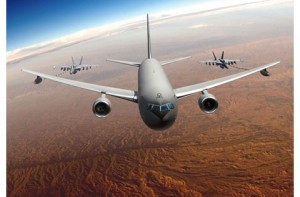
Boeing 767 tanker, refueling two F/A-18's
The United States Air Force has announced today that they have granted the tanker contract to Boeing and their 767 aircraft, which will be called the KC-46A. The Air Force is asking Boeing to deliver the first 18 aircraft by 2017.
This has been a heated battle between Boeing and EADS (the parent company of Airbus) for the contract worth $35billion dollars and 179 airplanes. Currently the Air Force has about 400 KC-135s currently used as tankers.Back in 2008, the Air Force initially gave the deal to EADS and their partner at the time Northrop Grumman. Since there were complaints about the bidding process, the whole process had to be started over again.
The Boeing 767 will be built in Everett, WA and modified for tanker duty in Wichita, KA. Washington representative Norm Dicks told Glenn Farely of KING5, “I am so excited that we finally won this after three go-arounds. It’s just the most important victory for Boeing, for the workers of our state.”
Although the decision has been made, it can still be appealed. At this point, I hope it does not get appealed so our troops can start getting new aircraft.
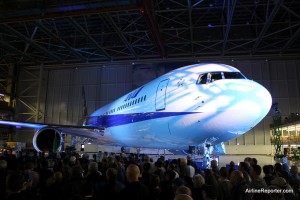
The 1000th Boeing 767 (JA622A) looked gorgeous in her newly painted ANA livery.
Yesterday was quite the milestone for Boeing. About three weeks ago, Boeing invited folks to check out the 1000th Boeing 767 during final assembly. It was a small gathering of people to remember how much the 767 has done for the airline community and looking forward to a possible tanker deal. Yesterday’s event was quite a bit larger and really felt more like a celebration.
Even though the 1000th 767, in All Nippon Airways (ANA) livery, was center stage, the ceremony really honored the past, present and future of workers who have had an impact on the 767. Bus loads of retired Boeing employees, who at one time or another worked on the 767 line, were taken to the factory floor and as the ceremony progressed, current Boeing employees gathered from all around the factory to join in on the event. We were all treated to multiple professional videos showcasing the 767’s past and there was even a 767 song that was surprisingly catchy (trying to work on getting a copy of that still).
This also gave an opportunity to look at the recent 767 production line reconfigurations. While fancy lights shined on the 1000th 767, the much less popular 1001st Boeing 767 looked on. Even though it didn’t get the attention it deserves, the 1001st aircraft will be the first to actually roll off the new 767 line. To create the new line, 8000 yards of concrete were removed, a building was partly cutdown, a new hangar door was installed and 767 tooling was moved around. It was quite the change and leaves the 767 a pathway from the rear of the factory to the front with just five feet of clearance in some areas.
During the event, Jim Albaugh, President and CEO of Boeing Commercial Airplanes, stated he was confident that the Boeing 767 would have a long life ahead of it, even if the tanker deal does not go through. “The 767 is still a very, very efficient airplane. In fact, from a trip standpoint, it’s the most-efficient twin-aisle airplane being manufactured (it’s also the smallest).” Albaugh continued, “And we have quite a number of customers we’re talking to right now about buying this airplane for commercial use. And I think we’ll be here, I hope, in another few years to be talking about the delivery of airplane 2,000.”
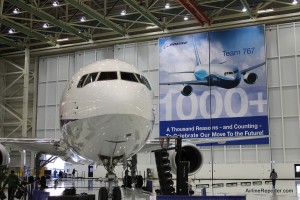
After the mood lights and crowd were gone, the 767 (JA622A) still looked beautiful.
This is not to say that Boeing doesn’t have every confidence that the 767 tanker will be chosen. “It’s the best airplane,” Albaugh said. “It’s an airplane that can put more booms in the sky. It’s an airplane that’s much more efficient to operate. It’s an airplane that can forward deploy to all the fields that the Air Force needs it to go to.”
After the ceremony, when Albaugh was asked how the older Boeing 767 will be able to effectively compete with the Airbus A330, he stated that the demand for wide body aircraft will be too great and with recent cost reductions in the aircraft, the 767 can will be a viable competitor. “We have figured out a way to take a lot of cost out of this airplane. And I think now that we’ve worked through that we’re going to have a very competitive offering going forward.” He also talked about the A320neo, the 777 replacement and outsourcing lessons learned on the 787. It’s all good information, but since Aubrey Cohen with the Seattle PI covered those parts so well, I don’t want to re-hash here.
Boeing has put a lot of time and money on the line for the future of the 767. I might not have the positive outlook for the 767’s future, if the tanker deal doesn’t go through, but I would imagine Boeing has looked how to convert the 767 line to produce 787’s if needed. Let’s hope one way or another it all pays off.
MORE GOODIES:
Of course you need more eye candy: here are 28 photos of the 1000th 767 event and a video from Boeing showcasing three generations on the 767.
It is interesting (at least to me) to see the different headlines that come from people attending the same event. I find it sort of refreshing. Here are some examples (all good reads btw):
* Boeing’s new 767 line ready to make Air Force tankers by Aubrey Cohen at Seattle PI
* Boeing rolls out 1,000th 767, but all eyes still on tanker deal by Glenn Farley at KING5
* Temporary 787 line in Everett could become more permanent by Michelle Dunlop with The Everett Herald
* Albaugh says Boeing’s 767 can still find customers by Dominic Gates with the Seattle Times
* Boeing Celebrates Completion of 1,000th 767 Jet by NYCAviation
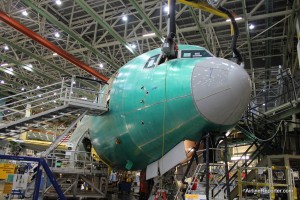
Boeing's 1000th 767 (JA622A) that is in the final assembly stage in the Boeing Factory.
Making just one aircraft is pretty darn impressive. Making 100 isn’t too shabby. But you know you have made it as an airliner if there have been a 1000 of your kind made. Although Boeing has made over 6600 Boeing 737’s, making 1000 767’s is nothing to sneeze at (wow, it would suck to be allergic to airplanes).
The 767 and 757 were designed together and were as close to siblings as airliners can get. They both have similar flight decks and handling abilities so that pilots could easily be cross-trained. The 767 was the first wide-bodied, twin-engine airliner that Boeing made and the first wide-bodied airliner to go to a 2-person flight deck crew. The first Boeing 767 took flight on September 26, 1981 and entered service with United airlines about a year later in September 1982. Since then the airplane has served many airlines well, but it might have always been a little jealous of its skinnier and more popular sibling, the 757.
When the last Boeing 757 was built in October 2004, there had been 1050 buit. For a while it seemed like the 757 would have been the more successful sister of the two aircraft as sales of the 767 have declined greatly over the past few years.
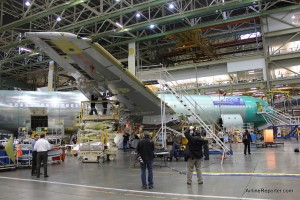
The 1000th Boeing 767 (JA622A) still have about a month til she will be delivered to ANA.
Currently, Boeing has delivered 995 Boeing 767’s and have another 50 on order. That means if the tanker deal doesn’t go through and no more aircraft are ordered, the 757 will go down in history with more aircraft built: 1050 vs 1045.
The Boeing 767 has remained in production for two major reasons: making it the next generation of military tanker and the Boeing 787 Dreamliner delays. Many airlines, including All Nippon Airways (ANA), were counting on the 787 Dreamliner to be completed long ago. Boeing has worked with airlines to provide them with temporary Boeing 767-300ER’s. “A couple years ago we started having discussions about providing 767s on an interim basis to some Dreamliner buyers as well as other carriers looking for twin-aisle planes. We saw interest from all regions for both passenger airplanes and freighters,” Leslie Hazzard with Boeing 767 Communications explained to me.
Although Boeing does say they have made deals with airlines, they aren’t willing to speak financial specifics, “We don’t discuss the financing terms that were considered, but at the time we said publicly that any deal would involve long-term commitments and need to make good business sense for both the airlines needing the lift and for the Boeing organizations involved,” Hazzard stated.
So, why bring up the 1000th Boeing 767 again? On Monday Boeing invited a few folks out to take a look at the final assembly of the 1000th 767, which will have registration number JA622A. ANA hopes to take ownership of the aircraft sometime during the third or fourth week of February. The special 1000th 767 event was pretty interesting. Boeing executives spoke at a podium next to the plane and workers from around the factory started to gather around and listen. Once the event was done, the workers went right back to getting the 1000th 767 ready to fly.
Right now, Boeing is storing three 787 Dreamliners on the current 767 line. There were two ANA 787’s (one in white livery, another in full livery) and one Air India. Unfortunately we weren’t able to take photos of the 787 at that time, but it was very cool seeing how different the ANA Boeing 787 Dreamliner parked right next to an ANA Boeing 767. The 767 is a wonderful aircraft that has served the world well and hopefully will continue to do so, but seeing it next to the 787, it is obvious that the Dreamliner is the next generation of airliner.
CHECK THIS STUFF OUT:
* 23 photos of the 1000th Boeing 767
* Story and video from Glenn Farley at KING5
* Story and photos from Aubrey Cohen at the Seattle PI
* Story from Michelle Dunlop on the Everett Herald
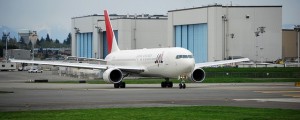
Japan Airlines 767-300 at Paine Field
Boeing recently did a little re-arranging at their Everett facility for the 767 line (check out Boeing’s video). Moving 200-tons of tools is not easy, but neither is making Boeing aircraft. Instead of taking apart the tooling apparatus and re-constructing it, Boeing decided to move it like an old house. Boeing hired an outside team to jack up the apparatus and drive it to its new location.
This move will decrease the number of days to make a Boeing 767 and increase the amount of space available on the production floor. The Boeing 737 and 777 programs completed a similar change a while back. A big change from previous lines is the exit for the line will be in back of the hangars and not the front.
Now, this just leaves the question, “why?” Boeing currently only has three orders for the 767 all from Azerbaijan Airlines, but there are 55 in the backlog waiting to still be built. The 767 was first introduced almost 30 years ago and there have almost been 1000 built. Many see the Boeing 787 as the replacement for the 767, so why put this money into an aging product?
I can only imagine this move is preparing to build the next generation of military tanker using the Boeing 767 frame. I was curious if Boeing would still plan to produce 767’s if they don’t win the tanker bid and I heard back from Leslie Hazzard, with Boeing Commercial Airplanes Communications.
She told me, “We continue to market and sell the 767 and plan to continue building it as long we see customer demand for the airplane. If we win the U.S. Air Force contract for replacement aerial refueling tankers, we will integrate Tanker production with commercial airplane production on an ITAR-compliant production line.”
It looks like Boeing is planning to win the contract and I feel they most likely will. If they don’t win the contact, will there be enough of a need for an updated Boeing 767 and a Boeing 787? That, I am not so sure about.
Image: Sabian404
Oops! Pilots on Qantas Airlines Forget to Lower Landing Gear
Qantas flight JQ12, a Boeing 767, was on approach at Syndney Airport on October 26th, when the pilots received a “gear too low” warning at about 700 feet. They had forgotten to put their landing gear down. They reacted quickly, aborted the landing and flew around again. Normally the aircraft should lower its gear between 2000 and 1500 feet.
It appears there was a communication breakdown between who was lowering the gear. Both pilots have stepped down during the investigation.
“The incident was reported to the ATSB and the pilots were stood down. We are supporting the ATSB’s investigation and our own investigations will determine what further action might be warranted,” a Qantas spokes person confirmed.
The airline states there was no “flight safety issue,” which I would have to disagree with. If the warning system had malfunctioned, this incident could have turned out much different. Putting down the landing gear is one of those important things to remember on a pilot’s landing checklist and should not be taken lightly when overlooked.
Source: News.com.au Image: Andrew Tallon
http://www.news.com.au/travel/story/0,28318,26303318-5014090,00.html
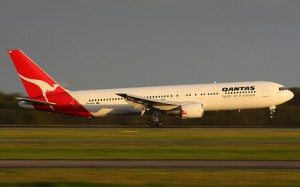
Qantas Boeing 767-300ER landing (with gears down)
A Qantas Boeing 767, was on approach at Sydney Airport on October 26th, when the pilots received a “gear too low” warning at about 700 feet. They had forgotten to put their landing gear down. They reacted quickly, aborted the landing and flew around again. Normally the aircraft should lower its gear between 2000 and 1500 feet.
It appears there was a communication breakdown between who was lowering the gear. Both pilots have stepped down during the investigation.
“The incident was reported to the ATSB and the pilots were stood down. We are supporting the ATSB’s investigation and our own investigations will determine what further action might be warranted,” a Qantas spokes person confirmed.
The airline states there was no “flight safety issue,” which I would have to disagree with. If the warning system had malfunctioned, this incident could have turned out much different. Putting down the landing gear is one of those important things to remember on a pilot’s landing checklist and should not be taken lightly when overlooked.
follow via | web | twitter | email | rss |
Source: News.com.au Image: Andrew Tallon






